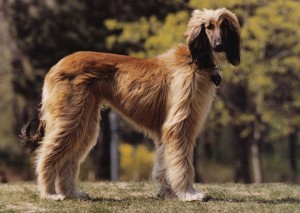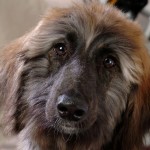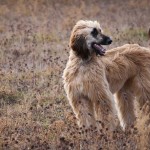Afghan Hound
"The majestic Afghan Hounds are descendants of some of the oldest dog types."
Other names for this breed:Tazi, Tazhi Spay, Da Kochyano Spay, Sage Balochi, Ogar Afgan, Eastern Greyhound/Persian Greyhound
Country of origin:Afghanistan
Traits:
Weight:Male 20–27 kg (45–60 lb)
Height:Adult male 61-73 cm 24–29 in)
Coat:Long and fine
Color:Fawn, Gold, Brindle, White, Red, Cream, Blue, Gray and Tricolor
Litter size:6-8 puppies
Life span:11-13 years
Classification:
AKC - American Kennel Club: Hound
UKC - United Kennel Club: Sighthound & Pariah
NZKC - New Zealand Kennel Club: Hound
FCI - International: 10 - Sighthounds, 10.1 - Longhaired Sighthounds
Are you ready to meet the most ancient breed of dog on earth? Looking for a dog that is just as at home in the show ring as it is as a watchdog, the lure coursing field, or even the hunting woods? Then look no further than the Afghan Hound. The Afghan Hound is a beautiful, regal creature that might the closest, genetically, you can find to a wolf in the domestic dog circle. Here, we will tell you more about this hound.
History
The Afghan Hound, as you might suspect, originates from Afghanistan. As sighthounds, they were used as hunting dogs, watchdogs, and companion animals. British military officers returning from places like India, Afghanistan, and Persia brought these sorts of dogs back to the UK with them in the 1800s. All the dogs in the UK and the US can trace their roots back to two main kennels and breed lines. Today, all of the major clubs in English speaking countries recognize this breed in the ring. People no longer use them in the hunting field.
Appearance
Once you have seen the Afghan Hound, it is not an easy breed to forget. They have long, silky coats that hang long. Their tails come up in a distinctive curl, topped with a ring. Afghan Hounds come in a wide variety of colors. Dogs might have black markings around the face that can appear as a mask or even a mustache. When first looking at the coat, most notice that the hair on the hind parts of the animals is relatively short compared to those hairs on the side. Past the long, silky coat, though, this breed is pretty slim.
Attitude
For a hunting dog, you will find that the Afghan Hound is pretty aloof and sensitive. They are not friendly to strangers. Instead, they often love one particular family or owner. This breed’s intelligence, paired with independence, makes it important to be careful with this dog. Handle them very gently. If you do not, do not be surprised if they become even more independent than before. As you might expect, the need for gentle treatment means that this does not always do so well in households with children. The Afghan Hound is very observant, and loves to track “prey”.
A Word About Grooming
The coat of this breed is absolutely beautiful. But understand that the coat takes a lot of upkeep. You should only think about purchasing this dog if you are fine with devoting a couple of hours each week to grooming. Most recommend that you brush or comb the coat at least once per day. You may want to hire someone to regularly do your grooming for you. When you are grooming, be very careful to handle your friend with care. Brush their teeth once every few days, as well. Be sure that you clip this hound’s nails at least once per month.
Care
In addition to all the care that must be taken with grooming, above, you must also check your dog’s ears each week to catch any potential infections. The Afghan Hound is definitely an indoor dog. They should be allowed to exercise on a daily, basis, however. Take them on a long walk and let them have some room to play off the leash in an area with a very high fence. Training this dog for obedience can be very challenging. As can socialization. Start them both very early. House training is especially difficult with this breed, so be patient.
Health Concerns
Like other very large breeds, the Afghan Hound has issues with under-active thyroid. They also may experience difficulties with cataracts. Allergies are probably the most common issue in this breed. You might notice that they are scratching, sneezy, feel very tired, and have watery eyes, as well as a running nose. Talk to your vet if you see any of these symptoms on a regular basis as they can help you to determine just what your dog is allergic to. In most cases, allergies can be controlled. Cancer is probably the most common reason for the death of this breed.
Getting Your Own Afghan Hound
If you are thinking about buying your own Afghan Hound puppy, seek out a reputable kennel or breeder. Be sure that any puppy that you purchase from such businesses come with their paperwork. You may also be able to find adult Afghan Hounds that are available for adoption. The Afghan Hound Club of America Rescue is a great place to start if you are in the US. For those in Canada, try the Afghan Hound Club of Canada for more information. Either of these organizations may be able to put you into contact with a local rescue that has Afghan Hounds up for adoption.
Afghan Hound Photo Gallery
You can click on the gallery images below to view them full sized (most are in wallpaper resolution!).























































